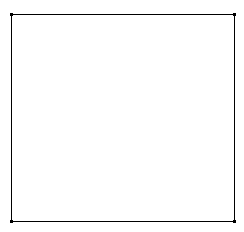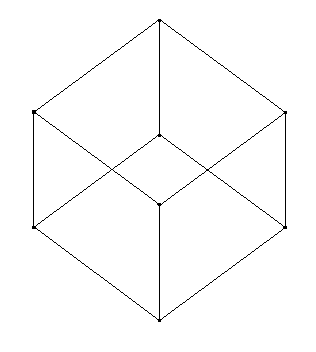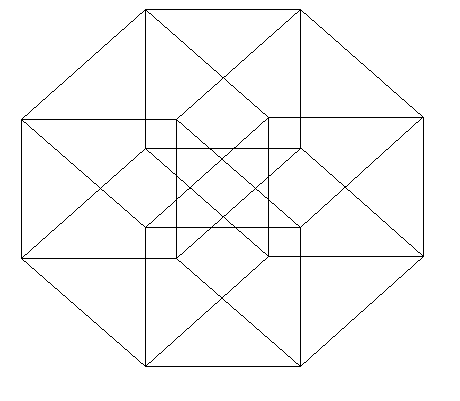
Starting from considerations regarding the ``components'' of cubes in various dimensions we find a recursive formula Hmn = 2 ·Hmn-1 + Hm-1n-1 which, incidentally, when generalized gives Euler's formula up to 3-d space and also establishes an analog of the formula for other spaces as well.This paper was intended for publication as an example of a way to find a formula which is done using higher math, topology in particular. But when I worked this out I was not familira with anything beyond a first year calculus course. Still, I thought someone may be interested in this (cumbersome) approach.MSC 54B20, 03D20
Euler's formula, V - E + F = 2, gives a relationship between the vertices edges and faces of polyhedra. A cube has, in fact, 8 vertices, 12 edges and 6 faces. Let us call vertices, edges and faces ``components'' of the cube. Now a square has 4 edges, 4 vertices and one face (which is the square itself). The components of the line segment are two vertices and one edge, the line itself.
We may imagine a cube being generated by moving a square orthogonally with respect to the plane containing the square. The square, in turn, being produced by ``dragging'' a line segment (its length is one side of the square) along the plane a distance equal to its length. We can say the square has been ``generated'' by the line segment. But the line segment itself may be considered as the one dimensional analog of the square, ``generated'' in turn by a point.
Going in the other direction, towards higher dimensions, with the cube we can generate a 4-dimensional hyper-cube, and so on.
One may then ask how many components make it up, that is, how many faces, vertices, edges and cubes (its analog of the 3-d faces) can be counted in it? For that matter, given an nth dimensional cube, how many components is it made up of?
In order to answer this let us first devise a suitable notation.
Let us designate a component by H, with the superscript indicating which component we are dealing with, and the subscript indicating in which dimension. The integer value of Hij then indicates the ith component in jth space.
So a vertex (point) in a 1-dimensional space will be H00, whereas, for example, a cube will contain H03 vertices. The number of edges (i.e. lines) for a given polygon in nth-dimensional space will be H1n, a face will be H2n, a cube H3n and so on. Obviously this will allow us to indicate as many dimensions as necessary, a 7th-dimensional hyper-cube will contain H77, H67, H57 1/4H07 components.
Let me introduce a recursive formula which will specify how many of a given component there are:
| (1) |
Given H00 = 1, we will define H-1n = 0 "n, thus giving the end values for the recursive formula. We should note that H may only assume non-negative values, for m £ n, otherwise it will be considered zero.2
Let us build up some concrete examples
For 0-dimensions we only have a point, and we have formally only one vertex, the point itself:
|
Given a line, we may consider a segment the 1-dimensional analog to the 2-dimensional square, and the formula gives us, the number of vertices:
|
and the number of edges (H1):
|
At this point we assert that, Hnn = 1. The proof is by induction, since H00 = 1, assuming it true for any particular n it follows that it is true for n+1.
|
That this should be so is intuitively clear, since it is the nth dimensional figure itself in n space that is being counted once.
It is also trivially true that H0n = 2 ·H0n-1. Again, it stands to reason, geometrically, that the number of vertices doubles as we ``drag'' an n-dimensional figure to create the (n+1)th-dimensional one.
That H1n = 2 ·H1n-1 + H0n-1 also stands to reason, since the number of edges will be twice that of the figure in (n-1)-space (its initial and final positions) plus the new edges created by the vertices being ``dragged''through n-space.

|
and for the edges:
|

|
and number of faces:
|
Continuing some of the generalizations we get the following closed formulas,
| ||||||||||||||||||||||||||||||
we also have
| ||||||||||||||||||||||||||||||
as well as:
| ||||||||||||||||||||||||||||||||||||||||
Carrying on some further generalizations we get the following closed formulas:
| ||||||||||||||||||||||||||||||
For H3n we proceed along the same lines as above, it is just a bit more tedious.
| ||||||||||||||||||||||||||||||||||
These may be proved by induction.
To summarize the closed formulae,
| |||||||||||||||
It may be interesting to see these in Euler's formula, but modifying it somewhat,3 applied to a cube (or rectangular prism):
| ||||||||||||||||||

|
number of faces that make up a hyper-cube:
|
and number of 3d components or cubes:
|
again applying the (analog) of Euler's formula:
| |||||||||||||
What is more interesting, generalizing Euler's formula using this notation we get:
|
we have, for the first few spaces En
For E0 and E1 the formulae are trivially true, and it is quite easy to show it for E2 as well.4 In E3 it is a trivial extension of Euler's formula, so that this is also true for all polygons.
The 4th dimensional analog of the tetrahedron, the smallest regular solid in E4 has 5 vertices, 10 edges, 10 faces and 5 (3-d) tetrahedrons. We can see that it too satisfies the general formula.
In E4 the proof for all hypercubes follows along the line of a proof for Euler's formula (at least as given in Courant's ``What is Mathematics?''), (Hnn - 1) - (Hn-1n - 1) + 1/4( H0n) = 1 leaves the value unvaried since the signs always alternate. We can continue the reasoning with the remaining components until we have reduced it to the identity 1 = 1 and this can be extended to E1 for any n hypercubes.
Now it remains to be proved for figures other than hyper-cubes, and the inevitable conjecture is that
for any n-dimensional space, for any simple convex polytope:
n
å
i = 0(-1)i ·Hin = 1 (2)
1 typeset by LATEX
2 That is, for m ³ n Þ Hmn = 0.
3 The modification is to include the 3-d figure itself, denoted by ``C''. The reason why the formula has been modified will become clear shortly.
4 Every plane polygon (including concave polygons) has one side for each vertex, and thus H02 = H12.
Last Update: February 6, 1999